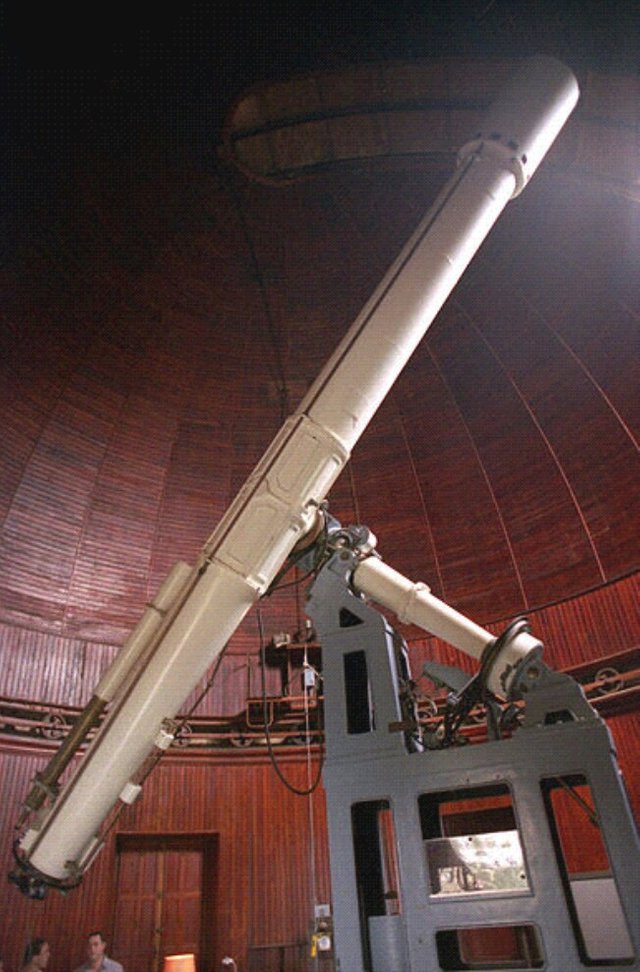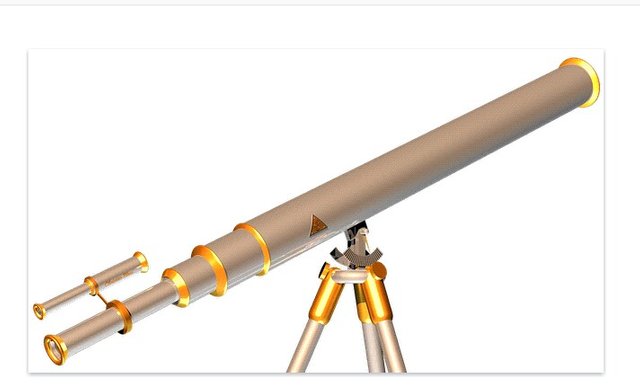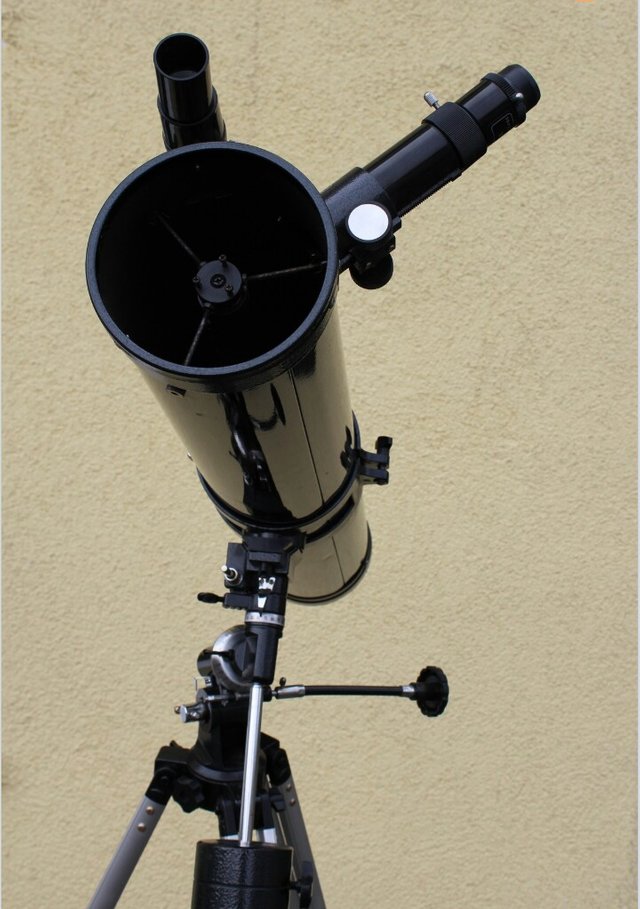Let's talk about Telescopes
What do you think of when you look at the sky for a longtime? Wouldn’t you like to take a closer look at the stars, moon or even the stars?
Well, the obvious question is why can’t our eyes see objects that are quite far? For instance, our naked eyes would not be able to see the handwriting on a dime if is placed 60 meters away because at such distance the handwriting do not take up much space on our retina. But then if we have “bigger eyes” we would be able to create an image that is brighter since we would be capable of collecting more light from the object, with this in place parts of the images can be magnified to ensure it stretches out over more pixels to our retina. This is what a telescope does to ensure we can see objects that are far away.
Today I would be taking a closer look at a telescope.
Telescopes are superb device that is designed to magnify objects that are at a distance and make those objects appear very close, they come in different shapes, sizes and specification depending on their use. It ranges from the heavy Hubble space telescope to the small plastic tube toy telescope we played with when we were much younger, there are some telescope that are used to perform superb actions even though they are not very sophisticated.
Typically, Telescope are of two main kinds which are the reflector telescope which utilizes mirrors and the refractor telescope that utilizes glass lenses. Although their operations are quite different but they both function to achieve the same result.
A telescope collects some amount of light from an object that is far away then it channels that light to a point of focus using the objective lens for refractors or primary mirror in reflectors. secondly the telescope utilizes an Eyepiece lens to transport the bright light from the point of focus and then magnifies this light to ultimately take up a large portion of the retina. It achieves this similar to the operations of a magnifying glass which captures a tiny image on a piece of paper and then spreads it out, so it would look big.
Basically, these two features are fundamentally what makes up a telescope, it collects lots of light which forms a bright image within the telescope, this bright image is then magnified so we can see the objects at far distance. The diameter of mirror or lens is what determines how well the telescope can collect light, so as a general rule the brighter the final image, the more light collected and focused by a telescope, the larger the aperture of the telescope. So this makes the aperture relatively more vital than magnification.
Refractors
Refractors are the kind of telescope which is very popular, they consist of a long tube (which is made of plastic, metal or even wood), located at the front end is an objective lens which is a glass combination lens and then an eyepiece which is a second glass combination lens. In this case the tube is ultimately responsible for keeping the lens at the required distance from each other and it also ensures that no interference as a result of dust, light or moisture occurs when the image is formed.
The objective lens basically collects the light and then refracts it such that it typically focuses on the back of the tube while the eye piece is responsible for bringing the image to the eyes of the user and then magnifies it, this is why the eyepiece of telescopes have shorter focal lengths especially when compared with the focal length of the objective lenses.
The eyepieces are made up of one or more lenses in combination depending on the design and they not only produce the sharp image but also allows the user change the magnification of the telescope to suit their needs. The Achromatic and Apochromatic refractors are the two main types of refractors. The resolution offered by refractors make them effective for seeing details in planets and stars, however due to its limited aperture, it’s not useful especially for situations where the user needs to observe faint, deep sky objects such as galaxies.
Reflectors
A reflector is a very simple device that have a relatively large light gathering capacity which make them suitable for observing deep sky objects since they can effortlessly produce bright images of faint objects for users. They utilize large aperture primary mirrors which are easily produced thereby making the overall cost of reflectors inexpensive.
However, a major shortcoming is that users would have to align the mirrors and clean them often to get best results such that a very small error in aligning the mirror can distort the image that is created which could lead to spherical aberration causing light difference in the focus of light reflected from the mirror’s edge than light reflected from the center.
Furthermore, every reflector experience light loss as a result of the obstruction of light entering the telescope caused by the secondary mirror and the type of reflective coating used for the mirror would determine the amount of light the mirror return as the light strikes the mirror.
However, there are some types of telescope known as the compound or catadioptric telescope that encompass the features of both the refractor and reflector element in their designs. It’s important to note that when using an average telescope to observe the sun, heat builds up within the tube and if proper precaution is not taken it can cause severe damage to the optical components of the telescope. So to ensure the telescope is not damaged, it’s necessary for users to allow the telescope cool off periodically by turning them away from the sun.
The optics that are used ultimately determines the ability of the telescope to collect light and it’s so crucial to utilize suitable optics to enjoy using a telescope because using a telescope that has poor quality optics can be quite ineffective. The following are some vital optical features:
The size of the primary mirror of a reflector or the objective lens of a refractor determine the amount of light a telescope can collect. As a general rule, the bigger the mirror or lens the brighter the final image generated, since more light would be collected and focused by the telescope. This makes Aperture the most crucial consideration when using telescopes.
The magnification capacity of a telescope is determined by the combination of lenses used and it is also a very important feature although it has little to do with the optical performance of the telescope. However, there must be a balance because the brightness and field of view of an image decreases as the magnification of that image increases. So to gather the most light for the telescope while viewing astronomical objects, they are viewed on low magnification.
Most times a short focal length eyepiece is combined with a long focal length primary mirror or objective lens for the best results. The distance required by the lens or mirror to focus all the light collected to a focal point is an important consideration for users. This distance is known as the focal length and it determines the magnification capacity of the telescope, so higher magnifications are derived from telescope with longer focal length.
Typically Glass or mirrors are not perfect, so the total performance of a telescope is determined by each optical component’s wave errors. So for users to enjoy using a telescope the image produced must be detailed and clear, this makes resolution an important consideration when using a telescope. Resolution is determined by the ability of the telescope to effectively separate two close objects.
Furthermore, the telescope mount is also a vital component in the operation of a telescope, these mount could come in different shapes, sizes, designs and sophistication but ultimately the stability of the telescope is what is paramount. Most mounts are designed to have adjustable heights for the users and they have low center of gravity so they can provide adequate support for the telescope.

CONCLUSION
Telescopes are superb tools that range from relatively simple to very complex designs. So You do not require the most powerful or expensive telescopes to bring the night sky closer to you. Just like several amateurs around the world you can decide to build or simply assemble your own telescope to suit your specific need instead of purchasing from manufacturers.
The crucial thing is to figure out what exactly you want to see so you can determine the type of telescope you would require so you can explore the superb details in the sky to unravel its numerous mysteries. Then you can take photos of what you see by attaching a camera to the telescope or by using a telephoto lens.

REFERENCES
If you write STEM (Science, Technology, Engineering, and Mathematics) related posts, consider joining #steemSTEM on steemit chat or discord here. If you are from Nigeria, you may want to include the #stemng tag in your post. You can visit this blog by @stemng for more details.

You can also join us at Promo-Mentors, to improve your blogging skills. Join our discord channel and meet awesome mentors who are willing and ready to shape your writing skills.





I think and wish for the stars to fall down on the ground for me to collect. :)
Very good research and writeup you have there. I came across your article through @roleerob who featured it on his post as an entry to the Pay It Forward Curation Contest. The contest is open to everyone so you are welcome to join.
Very funny comment about you wanting to collect stars
Thanks for the kind words
Well, you asked. I answered. :D
You're welcome.
Really comprehensive article about telescope @steematlas 😉 wish that you can show us how to build a telescope by ourselves too😊 but anyway thanks because through this post I don't have to do any research about telescope 👍👍👍 I always wonder about how its works and never have a chance to have one.
Found your post through @roleerob post in the pay it forward contest this week. I've seen some friends published moon photos and took the pict with phone camera with special apps, what a world.. a hubble in your hand😃
Thanks for stopping by@cicisaja
I would write about how to build a Telescope in my subsequent posts...
Watch out for my next article
Thaaaannkkk yoooouuu😉 I'll make sure I'll keep an eye to your blogs😊 you're Awesome!
Congratulations! Your post has been selected as a daily Steemit truffle! It is listed on rank 6 of all contributions awarded today. You can find the TOP DAILY TRUFFLE PICKS HERE.
I upvoted your contribution because to my mind your post is at least 8 SBD worth and should receive 163 votes. It's now up to the lovely Steemit community to make this come true.
I am
TrufflePig, an Artificial Intelligence Bot that helps minnows and content curators using Machine Learning. If you are curious how I select content, you can find an explanation here!Have a nice day and sincerely yours,

TrufflePigI wanted a telescope, as a kid... but I could never afford it. Then as I grew, I ended up losing interest.
Thanks for you post.
PS: I've found your post because @roleerob suggested it in his entry for The Pay It Forward Contest
Good evening (here) @steematlas. Working to do my small part in support of the great @pifc community, I am writing to let you know I have selected your post as an entry into their weekly contest.
I hope will find encouragement in learning this, to continue all you are clearly doing to add value to our Steem blockchain. Please follow the entry link above to find my supporting comments, to the PIFC Community, for their consideration of your efforts here.
All the best to you @steematlas, for a better tomorrow!
Congratulations @steematlas! You have completed the following achievement on the Steem blockchain and have been rewarded with new badge(s) :
Click on the badge to view your Board of Honor.
If you no longer want to receive notifications, reply to this comment with the word
STOP¡Hola @steematlas ! cuando miro el cielo lleno de estrellas, me siento nostalgica y romantica, llegue a tu publicación por que @roleerob, presento tu post, en el Pay It Forward Curation Contest , estas invitado a participar
Hi, @steematlas as you may know @roleerob featured you in this week's @pifc's Pay It Forward Curation Contest.
Informative and not boring. In fact it fed my desire to get a telescope. I could stare at the night sky for hours. Sometimes I just get lost in the beauty, other times I get lost in thought.
Congratulations @steematlas! You received a personal award!
You can view your badges on your Steem Board and compare to others on the Steem Ranking
Do not miss the last post from @steemitboard:
Vote for @Steemitboard as a witness to get one more award and increased upvotes!